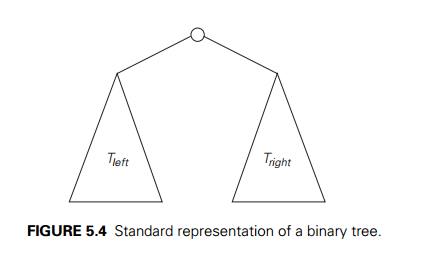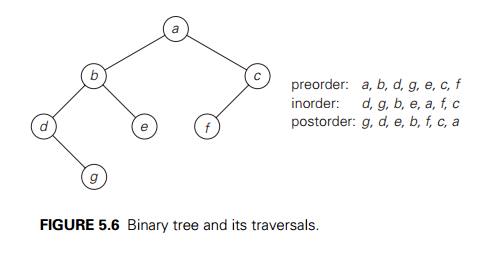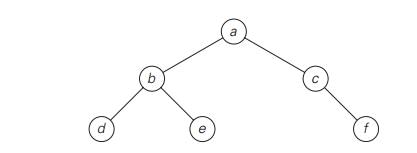Chapter: Introduction to the Design and Analysis of Algorithms : Divide and Conquer
Binary Tree Traversals and Related Properties
Binary Tree Traversals and Related Properties
In this
section, we see how the divide-and-conquer technique can be applied to binary
trees. A binary tree T is
defined as a finite set of nodes that is either empty or consists of a root and
two disjoint binary trees TL and TR called,
respectively, the left and right subtree of the root. We usually think of a
binary tree as a special case of an ordered tree (Figure 5.4). (This standard
interpretation was an alternative definition of a binary tree in Section 1.4.)
Since the
definition itself divides a binary tree into two smaller structures of the same
type, the left subtree and the right subtree, many problems about binary trees
can be solved by applying the divide-and-conquer technique. As an example, let
us consider a recursive algorithm for computing the height of a binary tree.
Recall that the height is defined as the length of the longest path from the
root to a leaf. Hence, it can be computed as the maximum of the heights of the
rootŌĆÖs left

and right
subtrees plus 1. (We have to add 1 to account for the extra level of the root.)
Also note that it is convenient to define the height of the empty tree as ŌłÆ1. Thus, we have the following
recursive algorithm.
ALGORITHM Height(T )
//Computes
recursively the height of a binary tree //Input: A binary tree T
//Output:
The height of T if T = Ōłģ return ŌłÆ1
else return max{Height(Tlef t ), Height(Tright )} + 1
We
measure the problemŌĆÖs instance size by the number of nodes n(T ) in a given binary tree T . Obviously, the number of
comparisons made to compute the maximum of two numbers and the number of
additions A(n(T )) made by the algorithm are the
same. We have the following recurrence relation for A(n(T
)):
A(n(T )) = A(n(Tlef t )) + A(n(Tright )) + 1 for n(T
) > 0,
A(0)
= 0.
Before we
solve this recurrence (can you tell what its solution is?), let us note that
addition is not the most frequently executed operation of this algorithm. What
is? CheckingŌĆöand this is very typical for binary tree algorithmsŌĆöthat the tree
is not empty. For example, for the empty tree, the comparison T = Ōłģ is executed once but there are no additions, and
for a single-node tree, the comparison and addition numbers are 3 and 1,
respectively.
It helps
in the analysis of tree algorithms to draw the treeŌĆÖs extension by replacing
the empty subtrees by special nodes. The extra nodes (shown by little squares
in Figure 5.5) are called external; the original nodes (shown
by little circles) are called internal. By definition, the
extension of the empty binary tree is a single external node.
It is
easy to see that the Height algorithm
makes exactly one addition for every internal node of the extended tree, and it
makes one comparison to check whether

the tree
is empty for every internal and external node. Therefore, to ascertain the
algorithmŌĆÖs efficiency, we need to know how many external nodes an extended
binary tree with n internal nodes can
have. After checking Figure 5.5 and a few similar examples, it is easy to
hypothesize that the number of external nodes x is
always 1 more than the number of internal nodes n:

To prove
this equality, consider the total number of nodes, both internal and external.
Since every node, except the root, is one of the two children of an internal
node, we have the equation

which
immediately implies equality (5.2).
Note that
equality (5.2) also applies to any nonempty full binary tree, in
which, by definition, every node has either zero or two children: for a full
binary tree, n and x denote
the numbers of parental nodes and leaves, respectively.
Returning
to algorithm Height, the number of
comparisons to check whether the tree is empty is

The most
important divide-and-conquer algorithms for binary trees are the three classic
traversals: preorder, inorder, and postorder. All three traversals visit nodes
of a binary tree recursively, i.e., by visiting the treeŌĆÖs root and its left
and right subtrees. They differ only by the timing of the rootŌĆÖs visit:
In the preorder
traversal, the root is visited before the left and right subtrees are
visited (in that order).
In the inorder
traversal, the root is visited after visiting its left subtree but
before visiting the right subtree.
In the postorder
traversal, the root is visited after visiting the left and right
subtrees (in that order).
These
traversals are illustrated in Figure 5.6. Their pseudocodes are quite
straightforward, repeating the descriptions given above. (These traversals are
also a standard feature of data structures textbooks.) As to their efficiency
analysis, it is identical to the above analysis of the Height algorithm because a recursive call is made for each node of
an extended binary tree.
Finally,
we should note that, obviously, not all questions about binary trees require
traversals of both left and right subtrees. For example, the search and insert
operations for a binary search tree require processing only one of the two
subtrees. Accordingly, we considered them in Section 4.5 not as applications of
divide-and-conquer but rather as examples of the variable-size-decrease
technique.

Exercises
5.3
Design a divide-and-conquer algorithm for computing
the number of levels in a binary tree. (In particular, the algorithm must
return 0 and 1 for the empty and single-node trees, respectively.) What is the
time efficiency class of your algorithm?
The following algorithm seeks to compute the number
of leaves in a binary tree.
ALGORITHM LeafCounter(T )
//Computes
recursively the number of leaves in a binary tree //Input: A binary tree T
//Output:
The number of leaves in T if T = Ōłģ return 0
else return LeafCounter(Tlef t )+ LeafCounter(Tright )
Is this
algorithm correct? If it is, prove it; if it is not, make an appropriate
correction.
Can you compute the height of a binary tree with
the same asymptotic ef-ficiency as the sectionŌĆÖs divide-and-conquer algorithm
but without using a stack explicitly or implicitly? Of course, you may use a
different algorithm altogether.
Prove equality (5.2) by mathematical induction.
Traverse the following binary tree
in preorder.
in inorder.
in
postorder.

Write pseudocode for one of the classic traversal
algorithms (preorder, in-order, and postorder) for binary trees. Assuming that
your algorithm is recur-sive, find the number of recursive calls made.
Which of the three classic traversal algorithms
yields a sorted list if applied to a binary search tree? Prove this property.
a. Draw a
binary tree with 10 nodes labeled 0, 1,
. . . , 9 in such
a way that the inorder and postorder
traversals of the tree yield the following lists: 9, 3, 1, 0, 4, 2, 7, 6, 8, 5
(inorder) and 9, 1, 4, 0, 3, 6, 7, 5, 8, 2 (postorder).
Give an example of two permutations of the same n labels 0, 1,
. . . , n ŌłÆ 1 that
cannot be inorder and postorder traversal lists of the same binary tree.
Design an algorithm that constructs a binary tree
for which two given lists of n labels 0, 1,
. . . , n ŌłÆ 1 are
generated by the inorder and postorder traversals of the tree. Your algorithm
should also identify inputs for which the problem has no solution.
The internal path length I of an extended binary tree is
defined as the sum of the lengths of the pathsŌĆötaken over all internal
nodesŌĆöfrom the root to each internal node. Similarly, the external path length E of an extended binary tree is
defined as the sum of the lengths of the pathsŌĆötaken over all external
nodesŌĆöfrom the root to each external node. Prove that E = I + 2n where n is the number of internal nodes
in the tree.
Write a program for computing the internal path
length of an extended binary tree. Use it to investigate empirically the
average number of key comparisons for searching in a randomly generated binary
search tree.
Chocolate bar puzzle Given an n ├Ś m chocolate bar, you need to break
it into nm 1 ├Ś 1 pieces. You can break a bar
only in a straight line, and only one bar can be broken at a time. Design an
algorithm that solves the problem with the minimum number of bar breaks. What
is this minimum number? Justify your answer by using properties of a binary
tree.
Related Topics